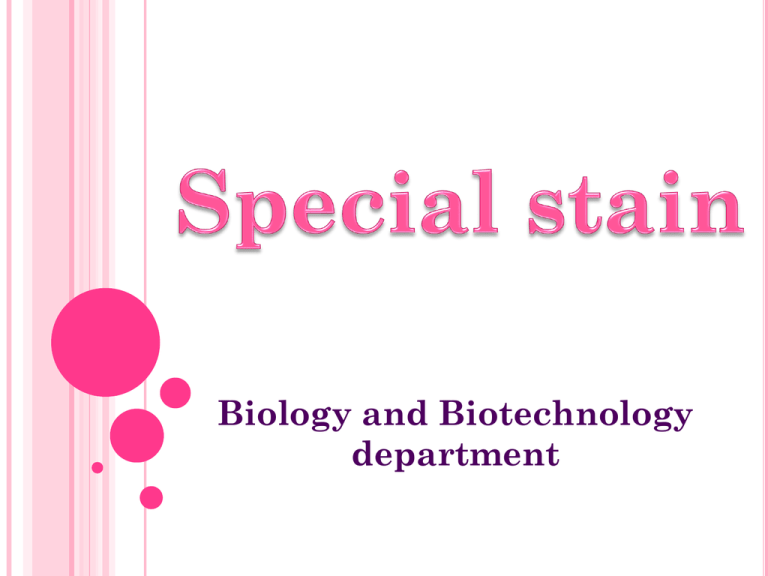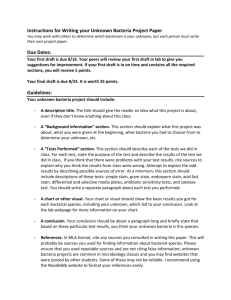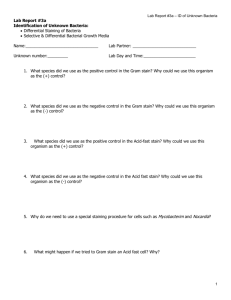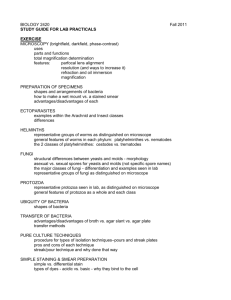CAPSULE
advertisement

Biology and Biotechnology department Many species of bacteria can exist in two very different states. In favorable environments, they exist as metabolically active vegetative cells. When the environment becomes unfavorable, these cells undergo the process of sporogenesis, and form intracellular endospores. When the vegetative cell degenerates and dies, the endospore is released as a spore. When conditions become favorable, the spore germinates to become a vegetative cell again. The endospore is highly resistant differentiated bacterial cells that are highly resistant to heat, boiling and drying out and are difficult to destroy, Stable for years. Do not confuse bacterial spores with fungal spores, which are very different structures. Several thick spore coats surround bacterial spores, making the spores very resistant to heat, cold, desiccation, radiation and a variety of chemical agents (including many microbiological stains). Special staining procedures must be used to visualize spores with compound microscope. Malachite green is the primary stain. In addition, the stain must be heated to penetrate the spore coat. The bacteria are decolorized with water. Malachite green is soluble in water unless it is bound to the spore coats. Safranin is the counterstain. When describing spore-forming bacteria, the location of the endospore is usually stated as central, terminal, or subterminal. Procedure 1. Make smears of each organism on separate slides. 2. Allow the slides to air dry, and then heat fix. 3. Apply a few drops of malachite green to the bacteria. Place the slides directly on a pre-warmed hot plate set on low for 5 minutes. Do not allow the stain to evaporate. Apply additional stain, if necessary. 4. Remove the slides from the hot plate and allow them to cool.. 5. Gently rinse the slides with water. 6. Apply enough safranin to the slides to cover the bacteria. Allow it to set for 30 seconds. 7. Gently rinse the slides with water. 8. Blot (don't wipe) the slides with bibulous paper. Allow the slides to air dry. 9. Examine the slides under oil immersion. The bacteria should appear pink; the spores should appear green. Examples: spore – forming bacteria : Bacillus , Clostridium None spore – forming bacteria : E.coli When a stain, such as an acid dye, cannot penetrate the outer layers of a microbe, the cell will appear transparent on a colored background. This stain is called a negative or background stain. It is performed by mixing the dye with a suspension of bacteria on a slide and spreading the mixture into a thin layer for viewing. Capsules :- are structures composed of carbohydrate or glycoprotein that lay outside of an organism's cell wall and thus are in direct contact with the environment. Many bacteria produce capsules under the right conditions. Bacteria with capsules: Streptococcus pneumoniae, Klebsiella pneumoniae, Pseudomonas putida Bacteria without capsules: E.coli Functions of a capsule :1. Protect the cell from desiccation (drying). 2. Protect the cell from phagocytes (being engulfed by white blood cells). 3. Provide a food reserve when certain organic compounds are in excess. 4. A virulence determinant of pathogenic microbes . 5. They serve as binding or adhesion agents for sticking cells together and/or to a surface such as a rock in flowing stream or a tooth . Capsules are not readily stained and therefore are visualized by negative stain techniques. The organisms are prepared as a smear in the presence of an acid dye and allowed to air dry because heat will cause the capsule to shrink. Usually the negative stain (which colors the background) is followed by a simple stain to color the bacterium. The capsule appears as a colorless layer between the bacterium and the background. Procedure:1. Use an inoculating needle to suspend the organism in a drop of India Ink at one end of the slide. 2. Place the short end of a clean microscope slide into the suspension and spread the mixture across the slide to form a thin layer. 3. Allow to air dry. Do not heat fix. 4. Cover the smear with methylene blue for 2-3 minutes. Rinse gently with water and allow to air dry. 5. Examine with oil immersion. 6. Diagram the appearance of the organism. Interpretation: Capsules appear as clear zones (halos) around the refractile organism. NOTES: Older cultures are more likely to exhibit capsule production. 2. When performing a capsule stain on your unknown, be sure the culture you take your sample from is at least five days old. 3. This stain is used for direct microscopic examination of capsules of microorganisms. 4. The India ink gives a semi opaque background against which the clear capsules can be easily visualized.




